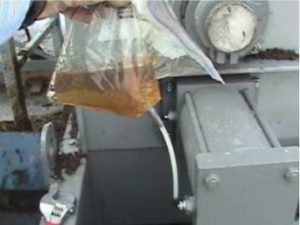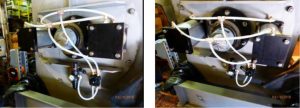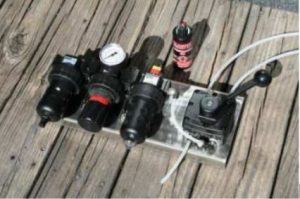The important item in this update is that air cylinder manufacturers now recommend against the use of lubricators. That shows up on the second page.
Because pneumatics are much simpler and less costly than hydraulics, the cake discharge cones of Vincent screw presses are actuated by air cylinders. We also use air cylinders in CIP backflush systems and elevation adjustment mechanisms for our Fiber Filters. This gets us into trouble-shooting air cylinders.
A common problem, especially with new units, is a sticky air cylinder. Sometimes the internal tolerances are so tight that, especially at low air pressures like 10 psi, the cylinder will stay stuck or move in jerks.
The best cure for a sticky air cylinder is to insert some STP Oil Treatment into the cylinder. STP is not called “motor honey” for nothing: it is as hard to pour into a small hole as is bee’s honey. The clever way to do this is to cut a hole in one corner of a freezer Baggie. Insert a piece of air hose through this hole, into the bag, and seal the joint with duct tape. Then pour STP into the bag, and seal the bag. When you squeeze the bag, it acts as a pump, making it relatively easy to get the oil to flow into the cylinder.

SQUEEZING STP INTO AN AIR CYLINDER
For small diameter, long strokes, we use Bimba air cylinders. The smaller of these are throwaway units: when the piston or seals start leaking, the unit must be replaced. Where the application calls for a larger diameter, we generally use TRD air cylinders. There are rebuild kits available for these.
An air cylinder will leak either at the shaft seal where the rod moves in and out, or past the seals of the internal piston. It is easy to find a leaky shaft seal by putting some bubble soap solution on the shaft. To check for a leaky piston, disconnect one of the air hoses, apply air to the other end of the cylinder, and see if air comes out the open port.
It used to be that a leaking piston meant that the internal bore of the air cylinder had rusted. But today cylinders are made of stainless, so the leak is apt to come from the piston’s seals. Sometimes an overhaul kit will fix this. But, it may be time to replace the air cylinder.
To regulate air pressure, Vincent presses used to come with an FRL (Filter, Regulator, Lubricator) set. We included a bottle of sewing machine oil for the Lubricator.
However, with the advent of stainless construction, our air cylinder suppliers now recommend NOT using a lubricator. Oil is no longer needed to prevent rust, and the air cylinder’s seals do not need lubricating. So today a simple air pressure regulator is all that is supplied with the press.
When you put compressed air to one end of an air cylinder, nothing will move until you let the air out of the other end. That is why the pressure regulator is followed by a 4-way valve. This pneumatic valve has four hose connections and a handle for two positions. In one position, compressed air from the regulator goes to one side of the air cylinder while the other end of the air cylinder is opened to atmosphere. In the other position, the air goes to the other end of the air cylinder while the opposite end is vented to atmosphere.
Moving the valve handle from one position to the other causes the air cylinder to push in the opposite direction, either opening or shutting the press discharge cone. Thus, there is a burst of air through the vent line whenever the valve handle is moved from one position to the other.
If air bleeds continuously from the vent line, it is a sign that air is leaking past the piston seals of the air cylinder. Alternatively, the air leaking could come from a dirty or faulty seat in the Parker valve.

PRESSURE REGULATOR SUPPLYING TWO AIR CYLINDERS

OLD STYLE FRL SET WITH 4-WAY VALVE
